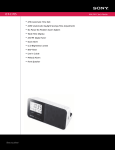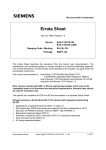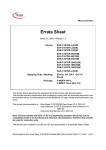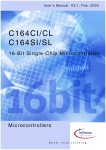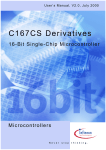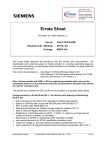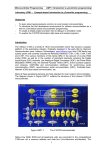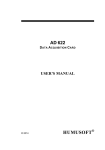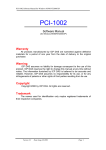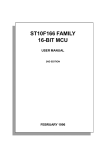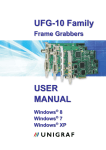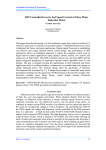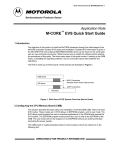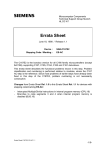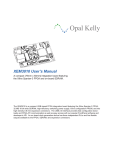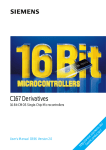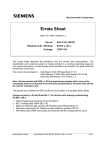Download C167CR-4R ES-AA (historic/no update)
Transcript
Microcomputer Components Technical Support Group Munich HL MC AT 1 Errata Sheet January 14, 1997 / Release 1.0 Device : Stepping Code / Marking : SAK-C167CR-4RM ES-AA The C167CR-4RM is the 32 Kbyte ROM version of the C167CR, including an onchip CAN module, 2 Kbyte XRAM module, and a PLL oscillator circuit. This errata sheet describes the functional problems known in this step. Problem classification and numbering is performed relative to modules, where the C167 AC-step is the reference. Since most problems of earlier steps have already been fixed in this step of the C167CR, problem numbering is not necessarily consecutive. The C167CR-4RM devices are mounted in a 144-pin Plastic Metric Quad Flat Pack (P-MQFP-144-1) package. Note: devices which are marked as ES-AA are engineering samples which may not be completely tested in all functional and electrical characteristics. They should be used for functional evaluation only. Changes from Errata Sheet Rel. 1.1 for C167CR-LM devices with stepping code/marking BA to this Errata Sheet Rel. 1.0 for C167CR-4RM devices with stepping code/marking ES-AA: - Problems ADC.8, CPU.8, CPU.9, CPU.11, RST.1, X10 fixed Start of Standard Conversion at end of Injected Conversion (ADC.10) PLL Unlock Behaviour (PLL.1) Deviations from DC/AC Specification Errata Sheet C167CR-4RM, ES-AA, 1.0 -1/6- Functional Problems The following malfunctions are known in this step: ADC.10: Start of Standard Conversion at End of Injected Conversion When an A/D conversion in any of the standard modes (single channel, auto scan, continuous modes) is started by software within a time window of 2 TCL (50 ns @ 20 MHz) before the end of an injected conversion, the following problem will occur: - the result of the injected conversion is not transferred to ADDAT2, and interrupt request flag ADEIR is not set - no further requests for injected conversions are processed - the standard conversion is not started (i.e. the A/D converter is blocked) Workaround: Do not start a standard conversion while an injected conversion is in progress. In this case, start the standard conversion in the ADEINT interrupt service routine which is invoked after the injected conversion is finished. As an indication whether an injected conversion is in progress, bits ADCRQ or ADST may be tested. - Main Program: ... ATOMIC #4 ; see Note 2) BMOV ADStart, ADCRQ ; copy current status of ADCRQ JB ADStart, Done ; injected conversion in progress ? BSET ADST ; no: start standard conversion here BMOV ADCRQ, CC31IR ; see Note 1) Done: ... ; yes: start standard conversion in ADEINT ISR - ADEINT Interrupt Service Routine: ... BMOV ADST, ADStart BCLR ADStart ... RETI Note 1): ATOMIC #4 should be used here to ensure correct flag handling and avoid side effects which may be caused by interrupts Note 2): In case ADCRQ has been set by a channel injection request from CC31 in the time between the second half of the decode phase and the second half of the execute phase of instruction BSET ADST, flag ADCRQ may be unintentionally cleared due to missing hardware bit protection of bit ADCRQ. This does not effect the actual start and processing of an injected conversion, since an internal (not user accessible) latch controls its correct operation. In case ADCRQ is polled by other routines to check whether an injected conversion is in progress, its state may be restored from flag CC31IR which is set simultaneously with ADCRQ upon each channel injection request from CC31. In this case, it is required that the ADEINT interrupt service routine properly clears flag CC31IR, or that CC31 interrupt requests are serviced by an own service routine or PEC. Compatibility with previous steps of the C167CR Errata Sheet C167CR-4RM, ES-AA, 1.0 -2/6- In previous steps (e.g. C167CR-LM AB-step), an injected conversion in progress was aborted when a standard conversion was started by software (see C167 User's Manual V1.0 or V2.0, p. 16-8, third Note). If this effect was not desired, it was suggested to check whether no injected conversion was in progress before starting a standard conversion. This means that all systems which have considered this proposal implicitly already have implemented the workaround described above and will work without problems also with the C167CR-4RM AA-step. In the C167CR-4RM AA-step, as a correction of problem ADC.7 (Channel Injection request coincident with start of standard conversion), start of standard conversions will no longer abort injected conversions. If this 'new' feature is used, the above software workaround must be used. If the abortion of an injected conversion by the start of a standard conversion was tolerated in sytems with previous steps (e.g. C167CR-LM AB-step), the workaround must be implemented when switching to the C167CR-4RM AA-step. PLL.1: PLL Unlock Behaviour When PLL operation has been selected during reset (P0H.7 = high), and the input clock at XTAL1 fails or becomes unstable, the PLL can not properly synchronize (lock) to the input clock, i.e. it is unlocked. In this situation, the following problems will occur: 1. the PLL output clock may not stay at the PLL basic frequency, but may vary between the basic and the maximum PLL frequency, depending on the transitions of the input clock at pin XTAL1. 2. when the PLL unlock condition occurs in particular during reset, it is not guaranteed that the PLL Unlock Interrupt Request Flag (XP3IR) is set to '1'. When the unlock condition occurs while the controller is not in the reset state, the PLL Unlock Interrupt Request Flag (XP3IR) will be correctly set to '1'. Note: when the direct drive option has been selected during reset (P0H.7 = low), and the input clock at XTAL1 fails or becomes unstable, the Oscillator Watchdog (if enabled) will supply the internal CPU clock with the PLL basic frequency. Functional Problem PLL.1 ADC.10 Short Description Remarks PLL Unlock Behaviour Start of Standard Conversion at end of Injected Conversion Table 1: Functional Problems of the C167CR-4RM Specific Problems with X-Peripherals (XPERs) Errata Sheet C167CR-4RM, ES-AA, 1.0 -3/6- The following problems with the interface to XPERs, the CAN module, and the XRAM module are currently known: X9: Read Access to XPERs in Visible Mode The data of a read access to an XBUS-Peripheral (XRAM, CAN) in Visible Mode is not driven to the external bus. PORT0 is tristated during such read accesses. Functional Problem X9 1) Short Description fixed in Step 1) Read Access to XPERs in Visible Mode refers to all devices with this stepping code (including engineering samples) Table 2: Functional Problems with XPERs on the C167CR-4RM Errata Sheet C167CR-4RM, ES-AA, 1.0 -4/6- Deviations from DC/AC Specification The following table lists the deviations of the DC/AC characteristics from the specification in the C167CR-4RM Data Sheet 12.96. Problem Parameter Symbol Limit Values Unit Test min. short name max. DCAH.1 ALE active current IALEH 1000 instead of 500 - µA Condition VOUT = 2.4 V DCRL.1 RD#/WR# active current IRWL -600 instead of -500 - µA VOUT = VOLmax DCP6L.1 Port 6 active current IP6L -600 instead of -500 - µA VOUT = VOLmax DCHYS.1 Input Hysteresis (Special Threshold) HYS 300 instead of 400 - mV - Table 3: Deviations from DC/AC Specification of the C167CR-4RM Errata Sheet C167CR-4RM, ES-AA, 1.0 -5/6- In addition to the description in the C167 Derivatives User's Manual V2.0, the following feature enhancements have been implemented in the C167CR-4RM: Incremental position sensor interface For each of the timers T2, T3, T4 of the GPT1 unit, an additional operating mode has been implemented which allows to interface to incremental position sensors (A, B, Top0). This mode is selected for a timer Tx via TxM = 110b in register TxCON, x = (2, 3, 4). Optionally, the contents of T5 may be captured into register CAPREL upon an event on T3. This feature is selected via bit QCAP = 1 in register T5CON.10 Compatibility with previous versions: In previous versions (e.g. C167CR-LM), both of the settings (TxM = 110b, T5CON.10 = 1) were reserved and should not be used. Therefore, systems designed for previous versions will also work without problems with the C167CR-4RM. Oscillator Watchdog The C167CR-4RM provides an Oscillator Watchdog (OWD) which monitors the clock at XTAL1 in direct drive mode. In case of clock failure, the PLL Unlock/OWD Interrupt Request Flag (XP3IR) is set and the internal CPU clock is supplied with the PLL basic frequency. This feature can be disabled by a low level on pin Vpp/OWE. See also C167CR-4RM Data Sheet 12.96. Bidirectional Reset The C167CR-4RM allows to indicate an internal watchdog timer or software reset on the RSTIN# pin which will be driven low for the duration of the internal reset sequence. This option is selectable by software via bit BDRSTEN/SYSCON.3. After reset, the bidirectional reset option is disabled (BDRSTEN/SYSCON.3 = 0). See also C167CR-4RM Data Sheet 12.96. Please note also the following functional difference to the C167CR-LM BA-step: XBUS Peripheral Enable Bit XPEN/SYSCON.2 In the C167CR-4RM, bit SYSCON.2 is a general XBUS Peripheral Enable bit, i.e. it controls both the XRAM and the CAN module. Compatibility with previous versions: When bit SYSCON.2 = 0 (default after reset) in the C167CR-4RM, and an access to an address in the range EF00h ... EFFFh is made, either an external bus access is performed (if an external bus is enabled), or the Illegal Bus Trap is entered. In previous versions (e.g. C167CR-LM), the CAN module was accessed in this case. Systems where bit SYSCON.2 was set to '1' before an access to the CAN module in the address range EF00h ... EFFFh was made will also work without problems with the C167CR-4RM. Errata Sheet C167CR-4RM, ES-AA, 1.0 -6/6-






